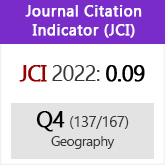Landscapes of central-western Spain with special consideration of dehesas
DOI:
https://doi.org/10.3989/egeogr.1994.i214.135Keywords:
Landscape units, Diversity, Classification analysis, PasturesAbstract
The typical landscapes of central-wetem Spain were studied, having chosen the province of Salamanca as a representative example. The study was approached from three levels according to preciseness: synthetic.- based on diversity and relative landrelief; descriptive.- regarding the whole province, with the establishment of, generally well defined, eight landscapes groups; detailed.- as far as the distribution of landascape units, related to pastures, was concemed.
Actually, the range of considered landscape units was sufficiently wide to demonstrate both those affected by human impact and those less influenced. Nevertheless, human activity was percieved practically m ali the instances. So that, frorn the 71 cartographic units, 15 were pastures of anthropological origin occupying a considerable part (more than 40 %) of the province. The optimal state, possibly, would be to conserve the major part of this territory as extensive pastures with sparse trees (dehesas). This would maintain the traditional land-use structure at the sarne time preserving the great biological and landscape values. In fact, the degraded state of landscapes in this region is due, in great measure, to the breakdown of the balance between land use and ecological capacity.
Downloads
Downloads
Published
How to Cite
Issue
Section
License
Copyright (c) 2021 Consejo Superior de Investigaciones Científicas (CSIC)

This work is licensed under a Creative Commons Attribution 4.0 International License.
© CSIC. Manuscripts published in both the printed and online versions of this Journal are the property of Consejo Superior de Investigaciones Científicas, and quoting this source is a requirement for any partial or full reproduction.All contents of this electronic edition, except where otherwise noted, are distributed under a “Creative Commons Attribution 4.0 International” (CC BY 4.0) License. You may read here the basic information and the legal text of the license. The indication of the CC BY 4.0 License must be expressly stated in this way when necessary.
Self-archiving in repositories, personal webpages or similar, of any version other than the published by the Editor, is not allowed.















